A7 LUBRICATION - THE
COMPLETE GUIDE
For the Austin Seven the following Lubricants are
approved by Austin Motors:—
Engine ..
CASTROL XL.
Gear Box ..
CASTROL XL.
Rear Axle..
CASTROL "D" Gear Oil.
Wheel Hubs
Wakefield CASTROLEASE Medium.
Universal Joint ..
CASTROL UNIJOYNT.
Chassis Grease
CASTROLEASE Medium.
Gun Nipples
CASTROLEASE Medium.
Electrical Equipment
Wakefield OILIT.
Above are outlined the units which require periodical
attention. These are dealt with separately in the following paragraphs, which
deal with every detail of the Austin Seven Lubrication requirements.
Engine
Before
starting the engine each day, check the oil level in the sump by means of the
dip-rod provided, and add CASTROL XL until oil reaches the "full" mark on the
rod (Fig. I). When your Austin Seven is new the crankcase should be drained
after the first 500 miles running and replenished with fresh oil.
How to Drain the Crankcase.
Whilst the oil is still warm after a run
remove the drain plug situated beneath the crankcase (Fig. 1) and allow the oil
to drain off completely, then replace the plug and refill with fresh oil of
correct grade as above.
Changing the Oil.
Because even the best oil tends to
become contaminated and diluted with fuel after it has been in use some time,
it is necessary to drain the crankcase every 1,000 miles after the first 500,
and replenish with fresh oil.
Cleaning The Oil Reservoir.
It is advisable every 3,000 miles to
remove the lower half of the crankcase (or oil reservoir). The gauze oil tray
will then be accessible. This should be removed and together with the oil
reservoir scrupulously cleaned with paraffin or petrol. When replacing,
carefully remake the oil-tight joint with the packing washer which should be
covered with grease on both sides.
Oil Flow Indicator.
This is situated on the Instrument
Board, and when the engine is running the button should always protrude under
pressure of oil. If the button fails to protrude the engine -should be
immediately stopped and the cause ascertained.
Oil Jets.
Lubrication of the big ends is effected
by oil forced from jets incorporated in the crankcase webs above the crankshaft.
Every 1,000 miles use this method to ensure that the jets are clean: Remove the
plugs situated over these jets and protruding above the cylinder head water
jacket, and insert a stiff piece of wire not exceeding 1/16 in. diameter through
the jets. Two of these plugs appear in Fig. 1, which illustrates their
accessibility for this operation.
The Clutch.
Every 250
miles apply three or four drops of CASTROL XL to the clutch thrust race. To
reach this swing back the oval clutch cover plate after loosening retaining
screws (See Fig. I).
It is well to remember that the clutch surfaces being
of fabric material must be kept free from oil and grease, or clutch slip will
soon be in evidence. For this reason, care should be exercised when applying oil
to the thrust race.
Gear Box.
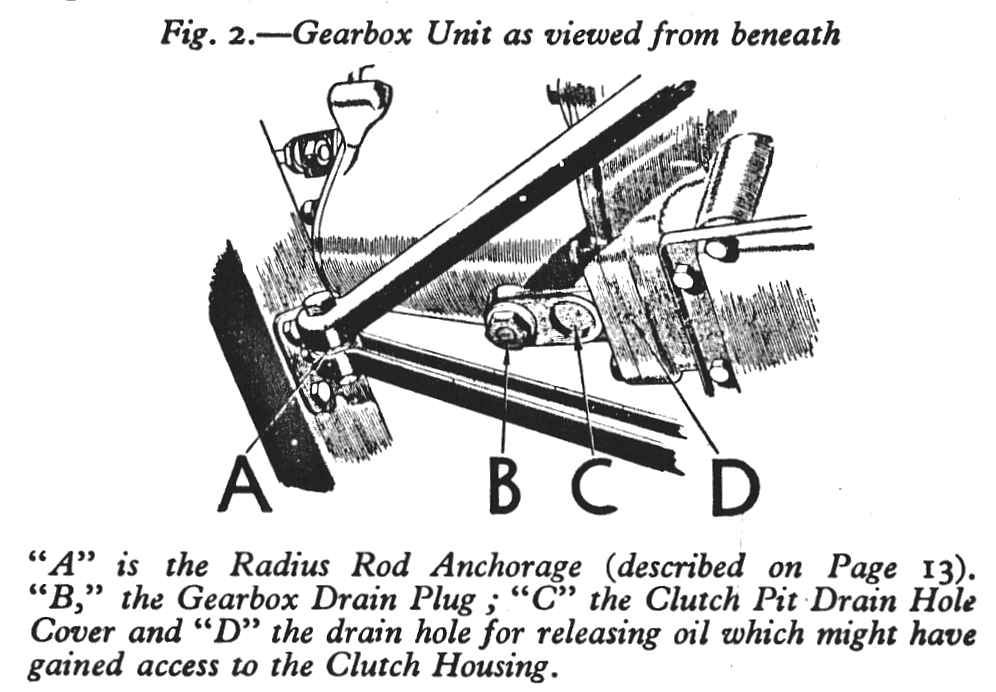 When
your Austin Seven is new the gear box should be completely drained after the
first 500 miles running. To do this remove the gear box drain plug (the position
of which is shown in Fig. t) whilst oil is still warm after a run. This drain
plug also holds the clutch pit drain hole cover in position as illustrated in
Fig. 2, and when refitting the drain plug this must be replaced.
When
your Austin Seven is new the gear box should be completely drained after the
first 500 miles running. To do this remove the gear box drain plug (the position
of which is shown in Fig. t) whilst oil is still warm after a run. This drain
plug also holds the clutch pit drain hole cover in position as illustrated in
Fig. 2, and when refitting the drain plug this must be replaced.
After draining, about two-thirds of a pint of CASTROL
XL is the maximum quantity required for complete replenishment of the gear box.
The amount of oil in the gear box can be checked by inserting the engine
dip-stick in the gear box filling orifice (Fig. 1). The depth of oil should
never be less than one inch or more than two and a half inches. It is advisable
to check this every 1,000 miles and maintain at the maximum level by
replenishing with CASTROL XL.
Changing the Oil.
Every 5,000 miles after the first 500
repeat the draining process previously described and refill with CASTROL XL.
Rear Axle.
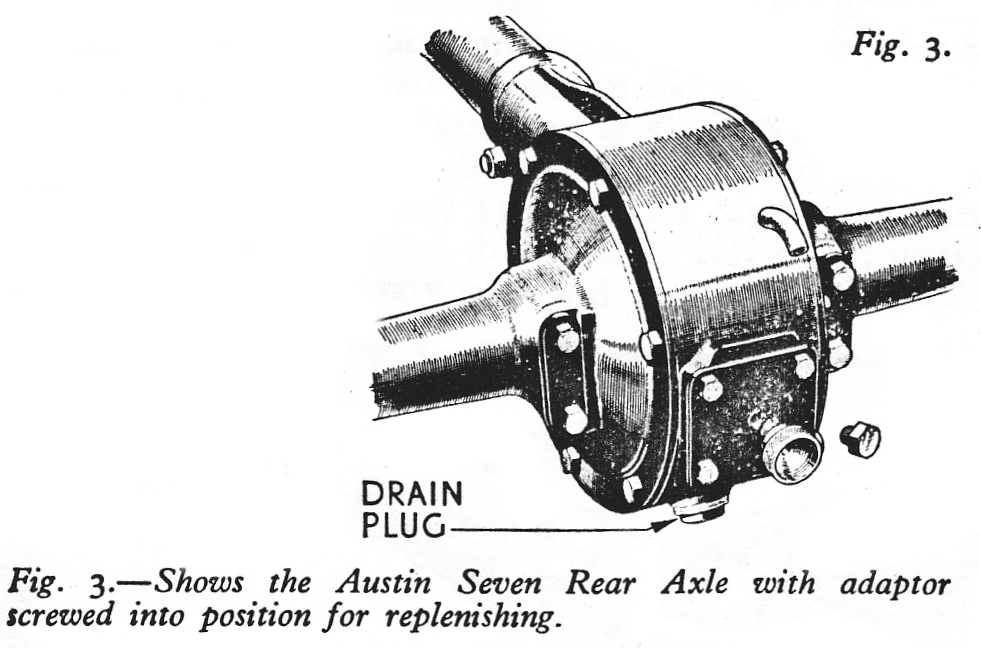 The
rear axle should be replenished every 1,000 miles with CASTROL "D" Gear Oil. To
do this, first remove the plug situated at the rear of the axle centre casing
(Fig. 3). Then screw the end of the grease gun adaptor into the hole, attach the
barrel of the grease gun and force in lubricant. Do not inject too much at any
one time, as oil is liable to reach the brake shoes and impair their
efficiency.
The
rear axle should be replenished every 1,000 miles with CASTROL "D" Gear Oil. To
do this, first remove the plug situated at the rear of the axle centre casing
(Fig. 3). Then screw the end of the grease gun adaptor into the hole, attach the
barrel of the grease gun and force in lubricant. Do not inject too much at any
one time, as oil is liable to reach the brake shoes and impair their
efficiency.
Steering Gear.
In order
to enjoy ease of steering and eliminate the possibility of "play" developing
between the steering wheel and road wheels through wear, regular lubrication at
all points of the steering gear is essential. The parts mentioned below can be
located by reference to Fig. 4
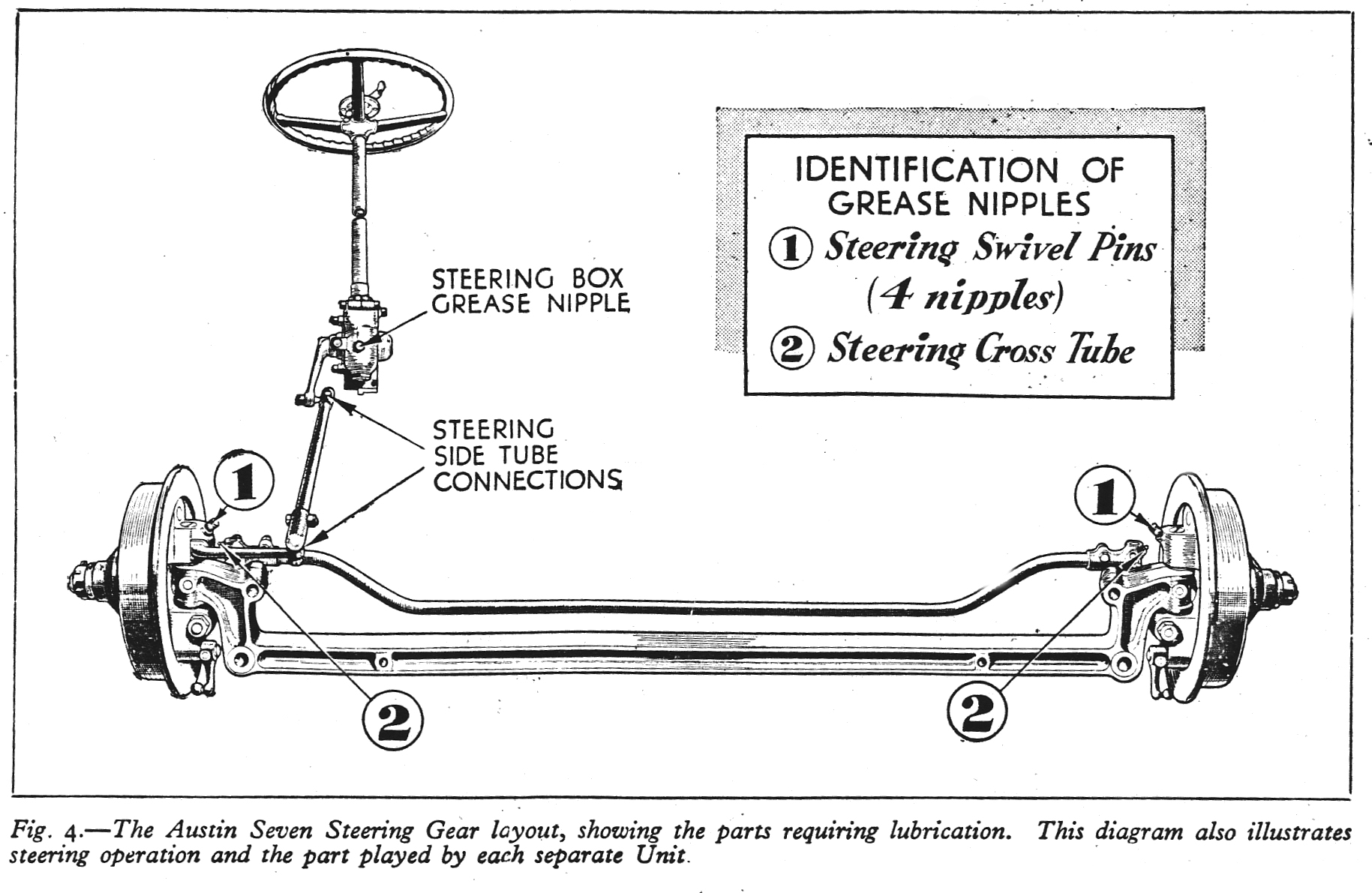 Steering
Gear Box.
Steering
Gear Box.
Every 1,000 miles give a charge of
Wakefield CASTROLEASE Medium with the grease gun at the nipple situated on top
of the box. This will lubricate the worm and worm wheel bearings.
Steering Column.
Give bearing at top of the steering
column a little oil from the oilcan every 250 miles.
Steering Side Tube.
Every 250 miles the steering connections
on this should be lubricated with CASTROL XL using an oilcan which injects the
lubricant under pressure into the sockets.
Steering Swivel Pins and Cross Tube.
Every 250 miles apply Wakefield
CASTROLEASE Medium with the grease gun at the nipples provided (there are four
of these in all).
Universal Joint.
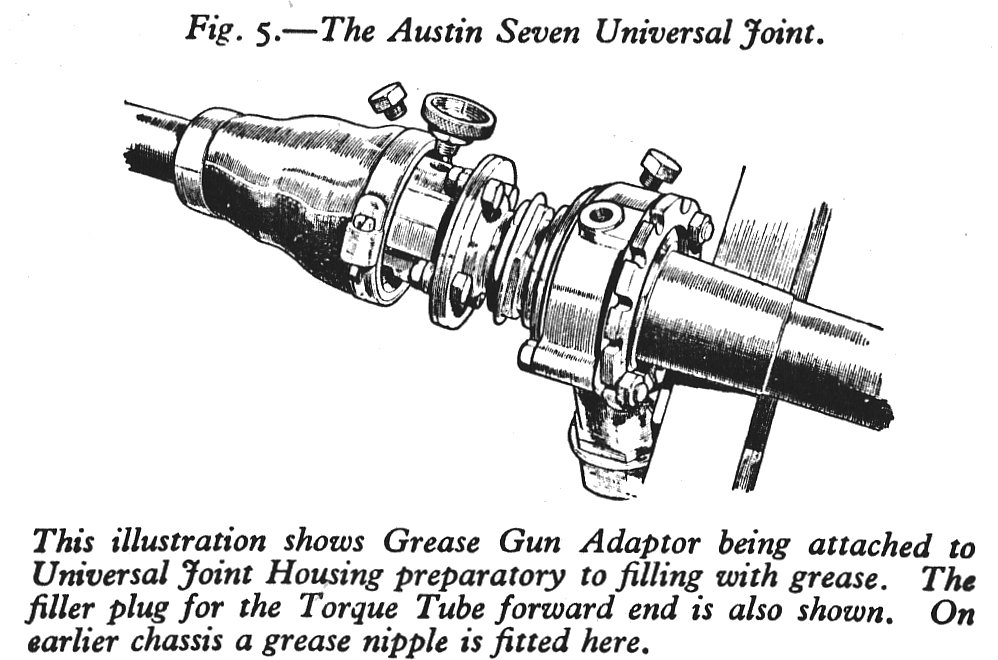 Every
250 miles fill the joint housing with CASTROL UNIJOYNT Grease. To reach this
point move aside the small cover in the car floor board. Now move the car until
the filling plug on joint housing is facing upwards. Remove the plug and apply
lubricant with the grease gun (see Fig. 5). CASTROL UNI JOYNT should always be
used here. It is a non-separating grease specially prepared for high-speed metal
joints. Do not neglect this point or rely on an inferior grease or unnecessary
play will very soon be in evidence.
Every
250 miles fill the joint housing with CASTROL UNIJOYNT Grease. To reach this
point move aside the small cover in the car floor board. Now move the car until
the filling plug on joint housing is facing upwards. Remove the plug and apply
lubricant with the grease gun (see Fig. 5). CASTROL UNI JOYNT should always be
used here. It is a non-separating grease specially prepared for high-speed metal
joints. Do not neglect this point or rely on an inferior grease or unnecessary
play will very soon be in evidence.
Just to the rear of the Universal joint is another
filling plug (or on the earlier model a grease nipple) for lubricating the
forward end of the torque tube. Apply Wakefield CASTROLEASE Medium here, using
the special adaptor if a filling plug is fitted.
Wheel Bearings.
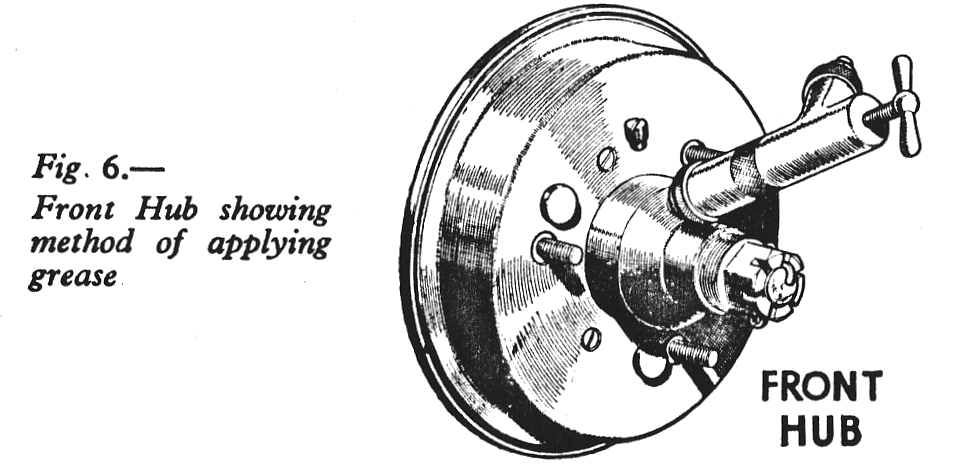 From
Hubs.
From
Hubs.
Every 1,000 miles remove road wheel and
turn the hub until the filling plug is at the top. Now remove the plug and screw
in the special adaptor provided in the tool kit. Apply six strokes of the grease
gun filled with Wakefield CASTROLEASE Medium (see Fig. 6). Do not forget to
replace the filling plug after detaching the grease gun.
Rear Hubs.
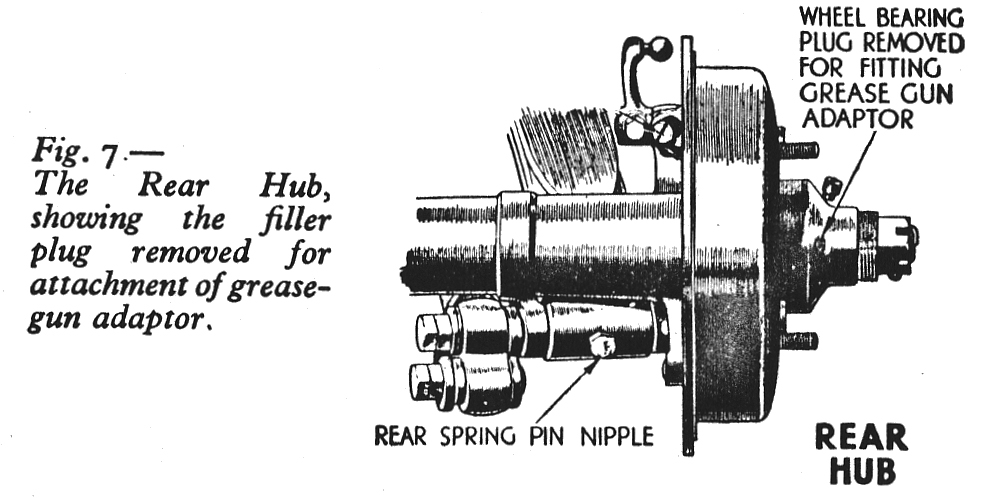 Lubrication
of the Rear Hubs should be carried out in the same manner as for front hubs. In
some instances, however, a grease nipple is fitted in place of the filling plug
shown in Fig. 7 below. When this is the case the screw-in adaptor will not, of
course, be necessary.
Lubrication
of the Rear Hubs should be carried out in the same manner as for front hubs. In
some instances, however, a grease nipple is fitted in place of the filling plug
shown in Fig. 7 below. When this is the case the screw-in adaptor will not, of
course, be necessary.
Brake Gear.
Cam Spindles.
Each rear brake cam spindle is provided
with an oil-less bush which does not require lubrication. No attention is
therefore necessary at these points. Front brake cam spindles are
lubricated from the swivel pin and require no separate attention.
Brake Joints.
Every 250 miles apply the oilcan to keep
the brake gear efficient and easy in operation.
Suspension Springs.
Spring Anchorages and Spring Shackle Pins.
These are all provided with easily
accessible grease gun nipples to which CASTROLEASE Medium should be injected
with the grease gun every 250 miles. There are six nipples in all. The one
fitted to the offside rear spring anchorage is illustrated in Fig. 7.
Spring Leaves.
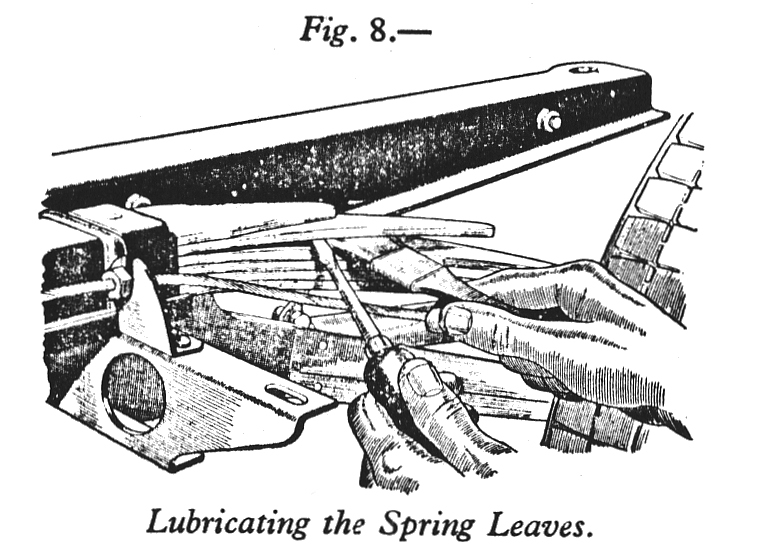 Every
10,000 miles it is necessary to lubricate these. In order to do this the weight
of the car must be taken off the springs and the spring leaves prised apart with
a screwdriver or similar instrument. To take the weight off the front spring
place the jack under the short cross-member just forward of the engine. The jack
should be standing on a wood block for this purpose. The rear springs may be
attended to one side at a time by jacking the car beneath either end of rear
crossmember. Having prised the spring leaves apart, apply Wakefield CASTROLEASE
"G" with a stiff brush between them. This operation is illustrated in Fig. 8.
Every
10,000 miles it is necessary to lubricate these. In order to do this the weight
of the car must be taken off the springs and the spring leaves prised apart with
a screwdriver or similar instrument. To take the weight off the front spring
place the jack under the short cross-member just forward of the engine. The jack
should be standing on a wood block for this purpose. The rear springs may be
attended to one side at a time by jacking the car beneath either end of rear
crossmember. Having prised the spring leaves apart, apply Wakefield CASTROLEASE
"G" with a stiff brush between them. This operation is illustrated in Fig. 8.
Radius Rod Anchorage.
The radius rods are anchored by means of
a ball flange and cups attached to the front crossmember just below rear end of
the gear box. Every 1,000 miles a few drops of engine oil should be applied at
this point. This is illustrated in Fig. 2.
Fan Bearing.
A nipple is fitted to this unit to which CASTROLEASE
Medium should be applied every 250 miles with the grease gun. This nipple is
shown in the top right-hand corner of Fig. 1.
Electrical Equipment.
Dynamo.
The dynamo bearings are packed with grease before
leaving the works and require very little attention. Every 1,000 miles, however,
add three drops of Wakefield OILIT through the lubricator near the mounting
flange (Fig. 1). It is well to note that far more trouble is caused by excessive
oiling than by too little.
Distributor.
 Every
5oo miles give the grease cup two turns. This will lubricate the Distributor
main bearing. This grease cup should be filled with Wakefield CASTROLEASE
Medium. At the same mileage interval apply two drops of Wakefield OILIT to the
cam lubrication wick through the hole provided (see Fig. 9). Take care not to
over lubricate these parts.
Every
5oo miles give the grease cup two turns. This will lubricate the Distributor
main bearing. This grease cup should be filled with Wakefield CASTROLEASE
Medium. At the same mileage interval apply two drops of Wakefield OILIT to the
cam lubrication wick through the hole provided (see Fig. 9). Take care not to
over lubricate these parts.
Windshield Wiper.
Every 1,000 miles apply a drop of
Wakefield OILIT to screen wiper mechanism. Except on the Trico model, a small
screw can be removed from the top of the casing to permit the oil to be
injected.
Starting Motor.
This Unit requires very little attention
as the bearings are packed with grease before leaving the works. Occasionally
remove the clip-secured commutator cover and inspect the commutator. This should
be kept free from oil, brush dust, etc., by the application of a soft cloth to
its surface whilst the spindle is slowly turned.
Also Requiring Attention.
Every
1,000 miles make a point of going round your Austin Seven and applying a few
drops of Wakefield OILIT to the carburettor and ignition control rod joints,
door hinges, bonnet fasteners, etc. It is a good plan, too, after nuts or screws
have been removed for any purpose, to apply a drop of oil before replacing
these.

 When
your Austin Seven is new the gear box should be completely drained after the
first 500 miles running. To do this remove the gear box drain plug (the position
of which is shown in Fig. t) whilst oil is still warm after a run. This drain
plug also holds the clutch pit drain hole cover in position as illustrated in
Fig. 2, and when refitting the drain plug this must be replaced.
When
your Austin Seven is new the gear box should be completely drained after the
first 500 miles running. To do this remove the gear box drain plug (the position
of which is shown in Fig. t) whilst oil is still warm after a run. This drain
plug also holds the clutch pit drain hole cover in position as illustrated in
Fig. 2, and when refitting the drain plug this must be replaced. The
rear axle should be replenished every 1,000 miles with CASTROL "D" Gear Oil. To
do this, first remove the plug situated at the rear of the axle centre casing
(Fig. 3). Then screw the end of the grease gun adaptor into the hole, attach the
barrel of the grease gun and force in lubricant. Do not inject too much at any
one time, as oil is liable to reach the brake shoes and impair their
efficiency.
The
rear axle should be replenished every 1,000 miles with CASTROL "D" Gear Oil. To
do this, first remove the plug situated at the rear of the axle centre casing
(Fig. 3). Then screw the end of the grease gun adaptor into the hole, attach the
barrel of the grease gun and force in lubricant. Do not inject too much at any
one time, as oil is liable to reach the brake shoes and impair their
efficiency. Steering
Gear Box.
Steering
Gear Box. Every
250 miles fill the joint housing with CASTROL UNIJOYNT Grease. To reach this
point move aside the small cover in the car floor board. Now move the car until
the filling plug on joint housing is facing upwards. Remove the plug and apply
lubricant with the grease gun (see Fig. 5). CASTROL UNI JOYNT should always be
used here. It is a non-separating grease specially prepared for high-speed metal
joints. Do not neglect this point or rely on an inferior grease or unnecessary
play will very soon be in evidence.
Every
250 miles fill the joint housing with CASTROL UNIJOYNT Grease. To reach this
point move aside the small cover in the car floor board. Now move the car until
the filling plug on joint housing is facing upwards. Remove the plug and apply
lubricant with the grease gun (see Fig. 5). CASTROL UNI JOYNT should always be
used here. It is a non-separating grease specially prepared for high-speed metal
joints. Do not neglect this point or rely on an inferior grease or unnecessary
play will very soon be in evidence. From
Hubs.
From
Hubs.
 Every
10,000 miles it is necessary to lubricate these. In order to do this the weight
of the car must be taken off the springs and the spring leaves prised apart with
a screwdriver or similar instrument. To take the weight off the front spring
place the jack under the short cross-member just forward of the engine. The jack
should be standing on a wood block for this purpose. The rear springs may be
attended to one side at a time by jacking the car beneath either end of rear
crossmember. Having prised the spring leaves apart, apply Wakefield CASTROLEASE
"G" with a stiff brush between them. This operation is illustrated in Fig. 8.
Every
10,000 miles it is necessary to lubricate these. In order to do this the weight
of the car must be taken off the springs and the spring leaves prised apart with
a screwdriver or similar instrument. To take the weight off the front spring
place the jack under the short cross-member just forward of the engine. The jack
should be standing on a wood block for this purpose. The rear springs may be
attended to one side at a time by jacking the car beneath either end of rear
crossmember. Having prised the spring leaves apart, apply Wakefield CASTROLEASE
"G" with a stiff brush between them. This operation is illustrated in Fig. 8.